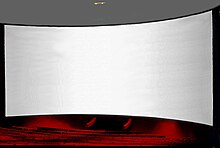
Back Cinerama Catalan Cinerama German Cinerama Spanish Zinerama Basque سینهراما Persian Cinérama French Cinerama Irish סינרמה HE Cinerama Italian 시네라마 Korean
This article needs additional citations for verification. (March 2023) |
 Scene from This Is Cinerama | |
| Type | Filmmaking technology |
|---|---|
| Inventor | Fred Waller |
| Inception | 1952 |
| Manufacturer | Cinerama Corporation |

Cinerama is a widescreen process that originally projected images simultaneously from three synchronized 35mm projectors onto a huge, deeply curved screen, subtending 146-degrees of arc.[2][3] The trademarked process was marketed by the Cinerama corporation. It was the first of several novel processes introduced during the 1950s when the movie industry was reacting to competition from television. Cinerama was presented to the public as a theatrical event, with reserved seating and printed programs, and audience members often dressed in their best attire for the evening.
The Cinerama projection screen, rather than being a continuous surface like most screens, is made of hundreds of individual vertical strips of standard perforated screen material, each about 7⁄8 inch (~22 millimeters) wide, with each strip angled to face the audience, to prevent light scattered from one end of the deeply curved screen from reflecting across the screen and washing out the image on the opposite end.[4] The display is accompanied by a high-quality, seven-track discrete, directional, surround-sound system.
The original system involved shooting with three synchronized cameras sharing a single shutter. This process was later abandoned in favor of a system using a single camera and 70mm (~2.75 inch) prints. The latter system lost the 146-degree field of view of the original three-strip system, and its resolution was markedly lower. Three-strip Cinerama did not use anamorphic lenses, although two of the systems used to produce the 70mm prints (Ultra Panavision 70 and Super Technirama 70) did employ anamorphic lenses, 35mm (~1.38 in) anamorphic reduction prints were produced for exhibition in theatres with anamorphic CinemaScope-compatible projection lenses.
- ^
- ^ "Cinerama | Wide-Screen, Cinematic, 3-Panel | Britannica". www.britannica.com. Retrieved May 13, 2024.
- ^ "Cinerama - The TV IV". tviv.org. Retrieved May 13, 2024.
- ^ "Cinerama". www.widescreenmuseum.com. Retrieved November 12, 2009.